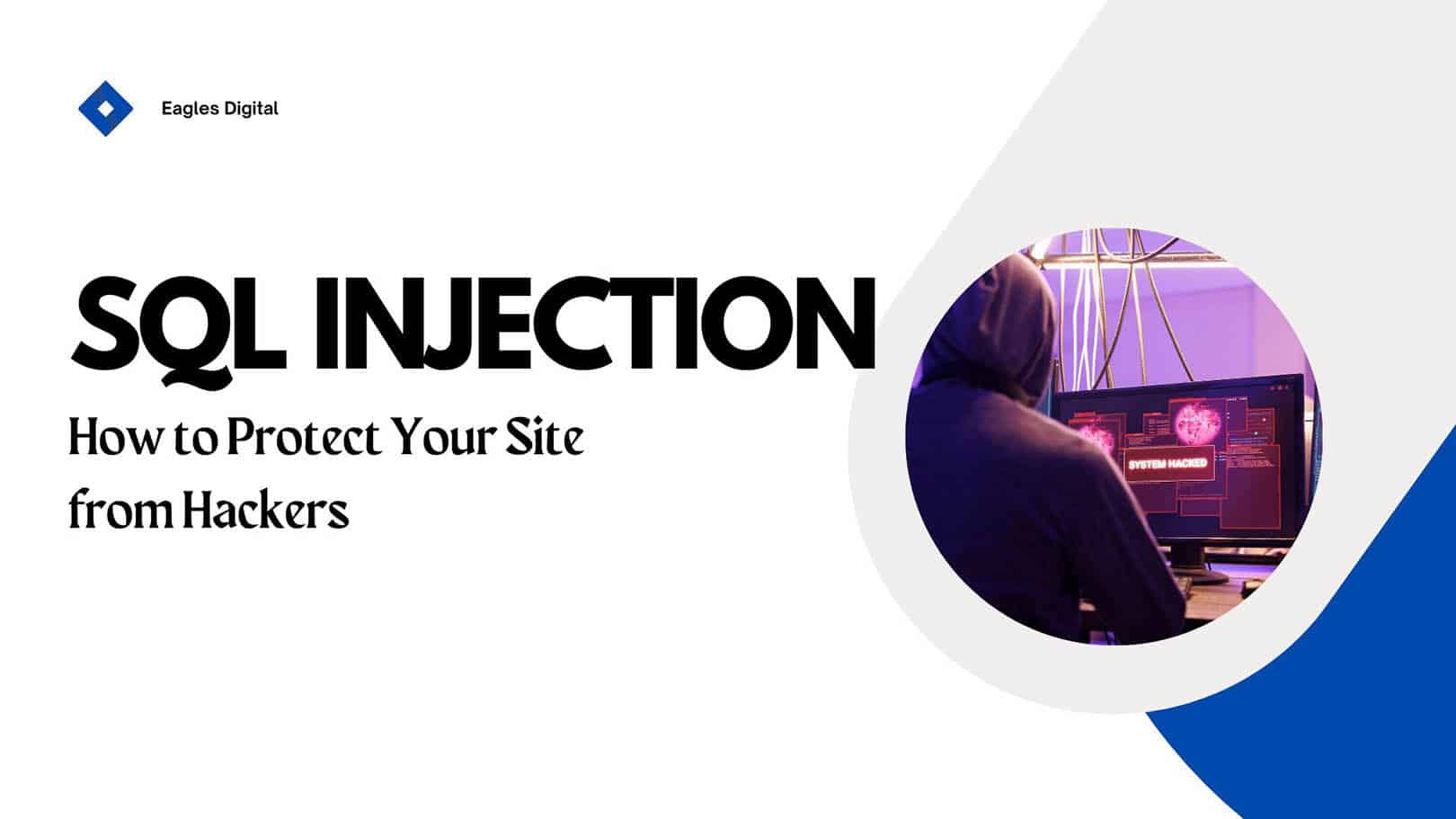SQL Injection: How to Protect Your Site from Hackers

SQL injection is a common cyberattack that can expose your website to serious security threats.
It occurs when malicious code is injected into vulnerable web application queries, allowing attackers to manipulate the database and potentially access, modify, or delete sensitive information. This type of attack can have devastating consequences for your website and business.
For anyone running a website or working with databases, understanding SQL injection and how to protect against it is crucial.
In this guide, we’ll explore what SQL injection is, how it works, and most importantly, how you can protect your website from this harmful attack.
What is SQL Injection?
SQL injection is a code injection technique used to attack data-driven applications. It’s one of the most common web hacking techniques and has consistently ranked in the OWASP Top 10 Web Application Security Risks.
At its core, SQL injection involves inserting malicious SQL statements into application queries to manipulate the database. This can lead to unauthorized access, deleting or modifying information, data theft, or a complete system takeover.
Websites relying on SQL databases like MySQL, Oracle, and SQL Server are more vulnerable to SQL injection attacks. Web developers and administrators must implement robust security measures to prevent such attacks.
How Does SQL Injection Work?
SQL injection exploits vulnerabilities in a website’s input fields, such as forms or URL parameters, by inserting malicious SQL code.
When a website directly passes user inputs into its SQL database without proper validation, attackers can manipulate the query and retrieve sensitive information, modify data, or execute harmful commands.
To better understand SQL injection, let’s start with a simple example. Imagine a login form on a website that takes a username and password.
The backend might use a SQL query like this:
SELECT * FROM users WHERE username = 'input_username' AND password = 'input_password'Now, if a malicious user enters the following as the username:
admin' --The resulting SQL query would become:
SELECT * FROM users WHERE username = 'admin' -- ' AND password = 'input_password'
In SQL, — denotes a comment, so everything after it is ignored. This query will return the admin user’s details without needing the correct password!
This is a basic example, but it illustrates the fundamental concept of SQL injection: manipulating the structure of a SQL query by injecting malicious code through user inputs.
Types of SQL Injection Attacks
SQL injection attacks come in various forms, each with its own characteristics, methods, and potential impacts.
Understanding these types in depth can significantly enhance your ability to protect against them. Let’s dive deeper into each type:
1. In-band SQLi
In-band SQLi is the most common and straightforward type of SQL injection. In this attack, the attacker uses the same communication channel to both launch the attack and gather results.
- Error-based SQLi
Attackers exploit error messages generated by the database to obtain information about the database structure. - Union-based SQLi
Union-based SQLi uses the UNION SQL operator to combine the results of two or more SELECT statements into a single result set.
2. Inferential (Blind) SQLi
In blind SQLi, no data is actually transferred via the web application, and the attacker can’t see the result of the attack directly in the application’s responses.
- Boolean-based SQLi
Boolean-based SQLi asks the database true or false questions and determines the answer based on the application’s response.
- Time-based SQLi
Time-based SQLi involves sending a query to the database which causes the database to wait for a specified amount of time before responding.
3. Out-of-band SQLi
Out-of-band SQLi is used when the attacker can’t use the same channel to launch the attack and gather results. It relies on the database server’s ability to make DNS or HTTP requests to deliver data to the attacker.
What are the dangers of SQL injection attacks?
The consequences of an SQL injection attack can be severe, impacting not only the security and functionality of the website but also the privacy and trust of its users.
Here are the key dangers of SQL injection attacks:
Data Breach:
One of the most common consequences of an SQL injection attack is data Breach. Attackers can access sensitive information stored in your database, including user credentials, personal information, and financial data.
For businesses like e-commerce and healthcare that process sensitive data, SQL injection attacks can result in serious privacy breaches and financial consequences.
Data Manipulation:
SQL injection can allow attackers to alter or manipulate data in your database, potentially causing irreparable damage. In extreme cases, attackers can delete entire tables or records, disrupting operations and causing data loss.
Unauthorized Access:
Attackers might gain administrative access to your database or even the entire system. With admin privileges, they can take over your entire system, change account credentials, lock out legitimate users, and take control of the website’s functionality.
Reputation Damage:
An effective SQL injection attack can severely damage the trust that customers place in your business. If customers’ personal information is exposed or the website is defaced, they may no longer feel safe using the service.
Financial Loss:
The costs associated with recovering from an SQL injection attack, potential legal ramifications, and loss of business can be substantial. Additionally, downtime caused by the attack can result in lost revenue, especially for e-commerce or SaaS platforms.
Compliance Issues:
For businesses handling sensitive data, a SQL injection attack could lead to non-compliance with regulations like GDPR, HIPAA, or PCI DSS. This can result in compliance violations, which often come with heavy fines and legal repercussions.
Plus, companies may face lawsuits from customers whose data was compromised.
How to Detect SQL Injection Vulnerabilities
Detecting SQL injection vulnerabilities early is crucial to prevent attacks that can lead to data breaches, loss of sensitive information, or even a complete compromise of the application. Here are some effective methods:
Manual Testing:
Test your application by entering various special characters , including malicious SQL code, to see if it can be injected into queries. You should also pay attention to error messages that reveal sensitive information or database structure. Manipulate URLs to inject SQL code and observe the application’s behavior.
Automated Scanning Tools:
Use vulnerability scanners like OWASP ZAP, Acunetix, or Netsparker to automatically detect potential SQL injection points. These tools can analyze your application’s code and behavior to identify potential weaknesses.
Code Review and Analysis:
Regularly review your code to identify potential SQL injection vulnerabilities. I also recommend you to use automated code analysis tools to scan your code for security flaws.
Secure Coding Practices:
Always use parameterized queries or prepared statements, which separate data from SQL code, making it harder for attackers to insert malicious commands. It also essentiel to validate user input to ensure it matches expected formats and prevent malicious code from being injected. Follow the principle of least privilege by granting database users only the permissions they need, reducing the risk of unauthorized actions.
Continuous Monitoring:
Implement a Web Application Firewall (WAF) to detect and block SQL injections in real-time, ensuring your site stays secure. Additionally, regularly analyze your application’s logs to spot any suspicious activity that may signal an SQL injection attempt, allowing you to take immediate action before any damage is done.
Remember, detection is an ongoing process. Regular security audits and continuous monitoring are essential for maintaining a secure website.
Best Practices to Prevent SQL Injection
Now that we understand the threat, let’s explore the best practices to protect your website from SQL injection attacks:
Use Parameterized Queries:
One of the most reliable ways to prevent SQL injection is to use parameterized queries (also known as prepared statements). These methods ensure that user inputs are treated strictly as data and not as part of the SQL command. By separating SQL code from user input, it becomes much harder for attackers to inject malicious SQL commands.
Example in PHP using PDO:
phpCopy$stmt = $pdo->prepare('SELECT * FROM users WHERE username = :username AND password = :password');
$stmt->execute(['username' => $username, 'password' => $password]);
In this example, even if $username is “admin’ –“, it will be treated as literal data, not as a SQL command.
Input Validation:
Input validation is the process of ensuring that the application is rendering only properly formatted data. This includes checking data types, formats, and ranges.
Example in PHP:
if (!filter_var($email, FILTER_VALIDATE_EMAIL)) {
die("Invalid email format");
}
Least Privilege Principle:
Ensure that database users only have the minimum necessary privileges. This limits the potential damage if an attack succeeds.
To implement this principle, you should create different database users for different parts of your application. Avoid using the root or sa account for application queries. Plus, regularly audit and update user permissions.
Use ORM Libraries:
Object-Relational Mapping (ORM) libraries often include built-in protections against SQL injection. These libraries provide an abstraction layer between your application and the database, reducing the risk of SQL injection.
Example using Laravel’s Eloquent ORM:
$user = User::where('username', $username)->first();Escape Special Characters:
If you must use dynamic SQL, escape special characters in user inputs. However, this should be a last resort – parameterized queries are safer.
Update and Patch Regularly:
Keep your database software, web server, and application frameworks up to date to ensure that you have the latest security patches. Keeping your software up-to-date helps close any vulnerabilities that attackers might exploit.
Implement Web Application Firewall (WAF):
A WAF can help detect and block SQL injection attempts before they reach your application. Popular WAF solutions include Cloudflare, Imperva, and AWS WAF. These solutions can help block malicious SQL injection attempts in real-time by identifying patterns commonly associated with SQLi attacks.
Error Handling:
Implement custom error pages to avoid exposing database error messages to potential attackers. Exposing detailed error messages to users can provide attackers with valuable information about your database structure, which can aid in SQL injection attacks.
Use Stored Procedures:
Stored procedures are SQL statements that are stored in the database itself. It can implement additional security checks and reduce the amount of SQL generated by the application when used correctly. When using stored procedures, make sure to bind parameters properly rather than concatenating user inputs directly into queries.
Prevention is always better than cure, so continuously monitoring your web application for vulnerabilities and taking proactive security measures is crucial to keeping your website secure.
Final thoughts on Sql Injection
SQL injection remains one of the oldest and most dangerous threats to web application security. As we’ve explored in this article, it’s a complex issue that requires a multi-faceted approach to prevention.
Whether you’re a beginner or an experienced developer, protecting your website from hackers should always be a top priority. By understanding SQL injection and following best practices for security, you can ensure that your website remains safe and secure.


